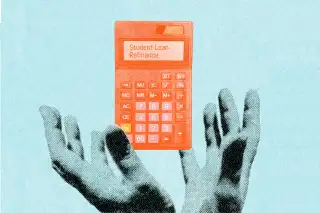Why Private Student Loan Borrowers Should Refinance Right Now

The rapid spread of coronavirus, and the fear that goes along with it, has driven the economy into a tail spin.
One small positive throughout all of the chaos is that interest rates have plummeted, helping some borrowers save money. Mortgage rates, for example, dropped to record lows earlier this month. And for the millions of borrowers dealing with student loan debt, this is a smart time to consider refinancing private loans to get a lower interest rate.
The rates on refinanced loans should drop to about 2.5% fixed and 1.25% variable, says Mark Kantrowitz, publisher and vice president of research at Savingforcollege.com. (Interest rates on new private loans, meanwhile, could drop to about 3.5% fixed and 2.0% variable, he says.) Rates at some lenders did increase in the past couple days, but Kantrowitz anticipates they will fall again.
It’s a much easier decision to pull the trigger on refinancing private loans, as opposed to federal student loans. With federal loans, you’re giving up access to a slew of benefits that private loans don’t offer. One brand-new example of those benefits? The passage of the Coronavirus Aid, Relief, and Economic Security (CARES) Act on March 27, 2020.
Under the provisions of this Act, most borrowers who have Federal Family Education Loans and Direct Loans held by the Department of Education will have their monthly payments automatically suspended until Sept. 30, 2020, without accruing interest or incurring in late payment fees or penalties. But that doesn’t apply to private loans or federal loans held by private lenders, and when you refinance those, you’re just swapping one private loan for another.
“The only one who wins by you not refinancing a private loan that costs too much is the lender who owns your debt,” says Travis Hornsby, founder of Student Loan Planner, which offers repayment advice for borrowers and connects them with refinance companies.
How Much Can You Save by Refinancing?
The amount you can save by refinancing depends on the total amount owed, your new loan term, and the difference between your existing and new interest rate. Of course, the lower the interest rate, the more money you can save.
Say you have a $40,000 student loan with a 7% interest rate on a 10-year term. If you are able to refinance to a 4% interest rate on the same term, you will save an estimated $7,100.
Hornsby says he’s seeing borrowers find rates one to two percentage points lower than their current rate, and in some cases, borrowers have gotten 5-year terms that are three to four percentage points lower. An average borrower could save thousands, he says.
“For borrowers with six figures in student loans, refinancing can often save the person a low- to mid-five figure amount in interest over the life of the loan,” Hornsby says.
While that lower variable rate is awfully tempting to optimize the savings, keep in mind that the number can go up a lot more than you’d like. Hornsby only recommends variable rates to borrowers who are able to pay off their debt within two years.
How to Find the Right Lender
Once you’ve decided that refinancing student loans is right for you, don’t just commit to the first lender you see.
“You need to shop around with at least three lenders to find a good deal,” says Hornsby.
Take time to research who is the best lender for your specific needs. Learn what options are offered for terms and length of loan repayment. Read reviews to get a sense of if the company is reputable and if the customer experience is a positive one. Search the fine print to see if they offer any assistance if you lose your job or can’t make payments. Finally, if you are opting to apply with a cosigner, check if the lender allows a cosigner release down the road.
To make yourself a better candidate, try to improve your debt-to-income ratio and apply with a creditworthy cosigner. If you can, pay down other debts, including credit cards or a car loan. And if you also have federal loans, you can switch to an extended or income-driven repayment plan to lower your monthly debt, Kantrowitz says. You should also check your credit report at annualcreditreport.com to correct any errors.
What You’ll Need to Apply
What you’ll need to get approved depends on each lender. You’ll definitely need the information on your current loan and proof of income. If you’re applying with a cosigner, you’ll need their income and basic information as well.
In most cases, lenders want to see consistent income, loans that aren’t in default, no recent bankruptcies, a reasonable debt-to-income ratio, a credit score of at least 650, and a minimum amount of debt to refinance. Many lenders require that you have graduated as well.